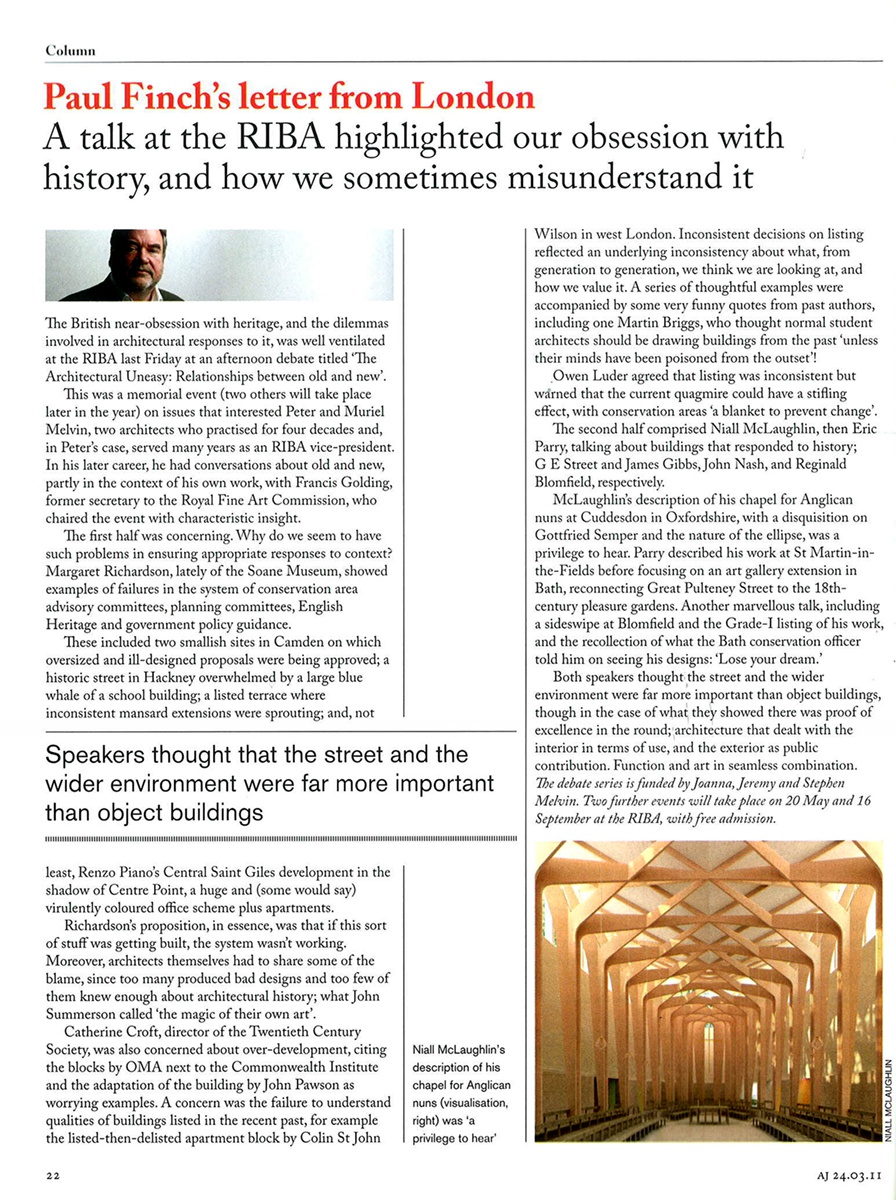Paul Finch’s Letter from London - Architects’ Journal
March 2011
Text Paul Finch
Images Níall McLaughlin Architects
A talk at the RIBA highlighted our obsession with history, and how we sometimes misunderstand it.
The British near-obsession with heritage, and the dilemmas involved in architectural responses to it, was well ventilated at the RIBA last Friday at an afternoon debate titled ‘The Architectural Uneasy: Relationships between old and new’.
This was a memorial event (two others will take place later in the year) on issues that interested Peter and Muriel Melvin, two architects who practised for four decades and, in Peter’s case, served many years as an RlBA vice-president. In his later career, he had conversations about old and new, partly in the context of his own work, with Francis Golding, former secretary to the Royal Fine Art Commission, who chaired the event with characteristic insight.
The first half was concerning. Why do we seem to have such problems in ensuring appropriate responses to context? Margaret Richardson, lately of the Soane Museum, showed examples of failures in the system of conservation area advisory committees, planning committees, English Heritage and government policy guidance.
These included two smallish sites in Camden on which oversized and ill-designed proposals were being approved; a historic street in Hackney overwhelmed by a large blue whale of a school building; a listed terrace where inconsistent mansard extensions were sprouting; and, not least, Renzo Piano’s Central Saint Giles development in the shadow of Centre Point, a huge and (some would say) virulently coloured office scheme plus apartments.
Richardson’s proposition, in essence, was that if this sort of stuff was getting built, the system wasn’t working. Moreover, architects themselves had to share some of the blame, since too many produced bad designs and too few of them knew enough about architectural history; what John Summerson called ‘the magic of their own art’.
Catherine Croft, director of the Twentieth Century Society, was also concerned about over-development, citing the blocks by OMA next to the Commonwealth Institute and the adaptation of the building by John Pawson as worrying examples. A concern was the failure to understand qualities of buildings listed in the recent past, for example the listed-then-delisted apartment block by Colin St. John Wilson in west London. Inconsistent decisions on listing reflected an underlying inconsistency about what, from generation to generation, we think we are looking at, and how we value it. A series of thoughtful examples were accompanied by some very funny quotes from past authors, including one Martin Briggs, who thought normal student architects should be drawing buildings from the past ‘unless their minds have been poisoned from the outset’!
Owen Luder agreed that listing was inconsistent but warned that the current quagmire could have a stifling effect, with conservation areas ‘a blanket to prevent change’.
The second half comprised Níall McLaughlin, then Eric Parry, talking about buildings that responded to history; G E Street and James Gibbs, John Nash, and Reginald Blomfield, respectively.
McLaughlin’s description of his chapel for Anglican nuns at Cuddesdon in Oxfordshire, with a disquisition on Gottfried Semper and the nature of the ellipse, was a privilege to hear. Parry described his work at St Martin-in-the-Fields before focusing on an art gallery extension in Bath, reconnecting Great Pulteney Street to the 18th century pleasure gardens. Another marvellous talk, including a sideswipe at Blomfield and the Grade-I listing of his work, and the recollection of what the Bath conservation officer told him on seeing his designs: ‘Lose your dream.’
Both speakers thought the street and the wider environment were far more important than object buildings, though in the case of what they showed there was proof of excellence in the round; architecture that dealt with the interior in terms of use, and the exterior as public contribution. Function and art in seamless combination.
